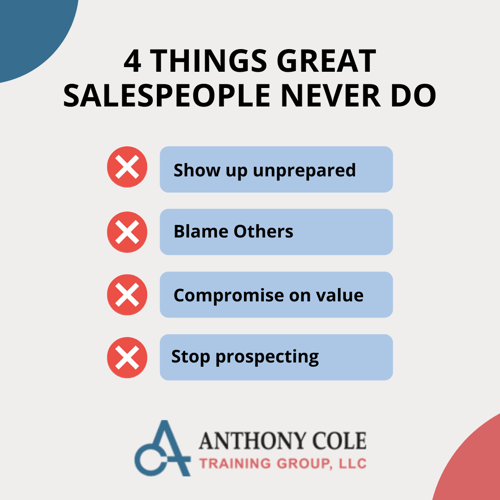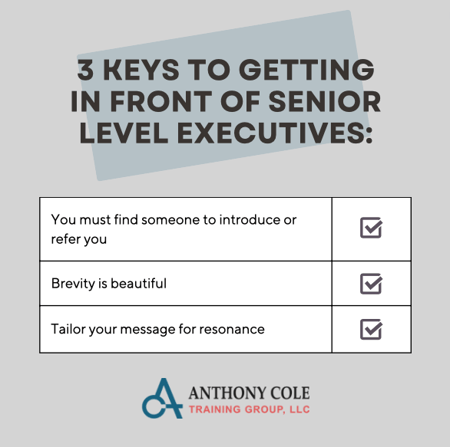Are your salespeople following the first commandment of sales success? Our new video series with Mark Trinkle introduces the 10 Commandments of Sales Success. Today we start with number one- Pre-Call Preparation.
Watch all of the Commandments Here
Sales & Sales Management Expertise Blog
Are your salespeople following the first commandment of sales success? Our new video series with Mark Trinkle introduces the 10 Commandments of Sales Success. Today we start with number one- Pre-Call Preparation.
Watch all of the Commandments Here
Topics: sales skills, pre call sessions, pre call preparation
I know you have heard it before. You know, the line that goes like this “if you keep doing what you have always done, you will keep getting what you have always gotten.” As a coach, the most development I have seen in salespeople comes when they alone decide enough is enough which leads them to make changes. And sometimes those changes are hard to make.
While there are many aspects that I love about my job, here are three in no particular order:
Today’s blog is about #3.
My sense is there are numerous articles and blogs on what great salespeople do…so today I want to flip that coin over and talk about what great salespeople never do. Perhaps they used to do those things, but at some point, in their sales career they drew a line in the sand and said no more. And those things became habits. They became the habits of sales greatness.
Here are four things great salespeople never do:
As a salesperson, what are you doing that you should stop doing? Who knows, you might be just one bad habit away from sales greatness.

Topics: great sales people, sales greatness
While there are many differences between elite salespeople and average salespeople, two of the more important distinctions are the ability to sell value (they can sell at a slight premium on price) and the ability to reach the top levels of the prospect’s decision-making team (typically the C-Suite).
It is the second of those two distinctions that serves as the title and the focus of this blog. Average salespeople are quite comfortable and successful seeing the non C-suite members of the decision-making team. Why are salespeople so comfortable with these people? The answer is quite simple – because these people are easy to see. They offer very little resistance. So here is a general rule of thumb: the easier the person is to get in front of, the less likely they will play a significant role in making the ultimate decision. To quote Eleanor Roosevelt, “never let anyone tell you no unless they also have the power to tell you yes.”Here are 3 keys to getting in front of senior level executives:
Happy selling. I need to go. I think I hear the ice cream truck heading by our office.

Topics: sales succes, sale skills, decisions
Knowing and understanding your prospect's buying motives allows you to make better decisions on whether to engage and pursue a potential sales opportunity.

Before I decided to pursue a business degree in college (yes, I know that was a long time ago), I briefly pondered studying psychology. I find some aspects of that field to be quite interesting in terms of understanding the things that drive people to make the decisions they make. In sales, I think about how to use this to understand customer buying motives. The great Dr. Sigmund Freud is credited with uncovering the pain-pleasure principle, which says that most decisions people make in their life are driven by the desire to avoid pain or obtain pleasure.
Think about that for just a minute and how far-reaching that is in your life. If you decided to get up early this morning and exercise, that was probably driven by the desire to avoid the pain of bad health. If you had a big helping of biscuits and gravy for breakfast this morning (don’t judge me) that was driven by the desire to obtain pleasure. If you are putting off having a difficult conversation with a co-worker, that is quite likely being driven by the decision to avoid the pain of a challenging discussion.
But what about your prospects? How much do you know about the buying motives of your prospects? Dr. Freud would say his pain-pleasure principle still applies. If you have been exposed to even a small amount of Anthony Cole Training Group content, then you know that we are huge believers in asking two questions of all prospects:
When we teach advanced selling techniques, we go one step further – we dig into what is going to motivate that prospect to make their decision. And we know that since change is hard, the easiest thing for a prospect to do is nothing. Not making a decision is making a decision, and that decision is often influenced by taking the path of least resistance, which is to maintain the status quo.
As it turns out, your most significant competitive threat may not be coming from one of your competitors. It might be PI, what I call prospect indifference, or just keeping with the status quo. And what would motivate a prospect to make that decision? Because it is an easy decision, the prospect can avoid the pain of change as well as the change of delivering unpleasant news to the existing service provider.
Think about your prospects or customers’ buying motives on your next sales call. It will allow you to make better decisions on whether to engage with a prospect. After all, shouldn’t one of your motives be to understand your prospect’s motives?
Topics: advanced sales techniques, buying motives, customer buying habits
In all moments of selling, there are many things that can go wrong. And when something goes wrong, it is in fact time to say “Houston, we have a problem.” But who is the “we” that caused the problem?

I have always loved President Theodore Roosevelt’s quote on problems: “If you could kick the person in the pants who is most responsible for most of your trouble you would not sit for a month.” Just like in tennis or golf, many of our problems are self-induced. They are “unforced errors.”
Our sales coaches, we are always dealing with sales challenges that span the entirety of the typical sales process. From the opening moments of finding a lead to uncovering an opportunity to presenting and getting a decision, there are many things that can go wrong. And when something goes wrong, it is in fact time to say “Houston, we have a problem.” But who is the “we” that caused the problem?
Speaking of Houston, I was there this week delivering a keynote address at the 2022 Mid America Lenders Conference. My training was on selling in a rate-sensitive environment which is a hot topic given that 2022 will be a year with multiple rate increases. In my keynote, I asked the attendees if they were working on the right end or the wrong end of the problem. When a prospect asks you at the end of the sales process for a concession (rate or terms), that tends to be a real trouble spot for salespeople.
Every company we work with believes in the power of having a value-based selling approach. None of them want to be the low-cost provider in their respective industry. And while we are called upon to help with last-minute or late-cycle negotiations, that is working on the wrong end of the problem. The right end of the problem is at the beginning of the sales process where it is essential to introduce value into the equation. After all, the primary reason why salespeople struggle to defend value at the end of the sales process is that they fail to introduce that value at the beginning of the sales process.
From the sales assessment tool that we use by Objective Management Group, here are the skills of a value-based seller:
Start helping yourself by positioning your value early. Make it impossible for your prospect to miss it. Find out if your prospect values it and protect your bottom line.
Topics: sales challenges, value-based selling

Anthony Cole Training Group has been working with financial firms for close to 30 years helping them become more effective in their markets and closing their sales opportunity gap. ACTG has mastered the art of using science-based data and finely honed coaching strategies to help build effective sales teams. Don’t miss our weekly sales management blog insights from our team of expert contributors.
Anthony Cole Training Group, LLC